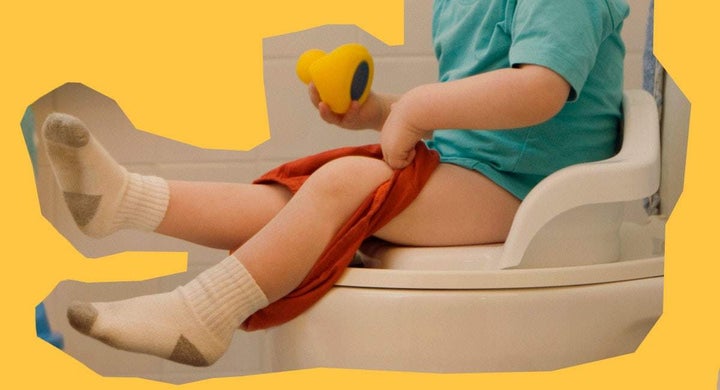
Here’s the best advice when toilet training doesn’t work: Chill. It can differ by culture or country, but most children in America learn to toilet train between two-and-a-half and three-and-a-half years of age. That’s generally when they have developed the necessary gross motor skills and are psychologically ready to successfully toilet train. Understandably, a lot of parents jump the gun and then get frustrated. Thus the advice: Chill.
“If someone is trying to train an 18-month-old, and it’s not working, the reason it’s not working is because the child is too young,” says Dr. Howard J. Bennett, MD, FAAP, who is author of AAP’s book, Waking Up Dry: A Guide to Help Children Overcome Bedwetting. “As a general rule, if parents are feeling some rush to teach their children to use the toilet, it’s often a sign that things aren’t going to go well. Learning to use the toilet is the child’s process of mastering a particular skill. It’s having to recognize that it’s time to pee or poop, to be able to hold those muscles until they can get to the toilet and let go. And so some children will be ready at two, but others aren’t ready until three.”
When a child is ready for potty training, they may show interest by imitating older siblings or showing general curiosity about how the bathroom works. They might be distressed at having a wet or soiled diaper. Or they may simply say they want to learn.
Toilet training is a process that requires patience and, despite some amazing numbers put up by the professionals, will take time. Even kids who are enthusiastic partners in toilet training can have accidents, sometimes for months or years. And some kids may demonstrate the physiological and psychological milestones to begin toilet training, but won’t engage at all, or will openly resist.
“Toilet training is a process that requires patience and, despite some amazing numbers put up by the professionals, will take time.”
Kids are often put off by the novelty of the new experience. Diapers have been a part of their entire lives up to now, so a toilet just looks like unnecessary work. Or they could have legitimate physical concerns they don’t always understand or know how to communicate. Sitting on a full-sized toilet without a kid’s seat can be very intimidating – its easy slip right through the hole. If kids don’t use a stool for their feet, they can have some discomfort in the back of the leg. They may get splashed with toilet water when they drop a deuce, which feels pretty weird at any age, or pass a hard bowel movement, which can really hurt. Humans are pretty quick to form patterns where there aren’t any, and any negative experience can be extrapolated into a discouraging toilet gestalt.
Luckily, those kinds of problems are fairly simple to address: buy a stool, buy a training potty or a potty seat, and have the child drink more water. Sometimes a reward system can coax a reluctant child to engage again. A kid might think a treat, or a sticker, or a prize to work toward is worth it. And if that doesn’t work, just remember: be chill. One of the biggest stumbling blocks to potty training – and the most subtle – is stress. It’s hard for both parents and children to identify, but very easy to succumb to.
“Children are really experts at picking up parental stress,” explains Bennett. “If you feel frustrated, they will feel frustrated as well.” Getting frustrated at those earlier, easy-to-fix problems may generate a new problem, where trying to toilet train is simply too stressful to be worth it. Which is too bad, because the toileting process doesn’t have to be stressful at all.
The fact is most of the pressure to potty train comes from sources and obligations outside the family – day care or preschool requirements, grandparent’s standards, comparisons to friends who had early success – but none of that motivates the kid. Instead, it just adds pressure to the parents. In that environment, even benign suggestions to use the potty, no matter how gently they seem to be made, can increase the stress level.
“If it’s not going well, and parents have explored all these things that may have tripped them up, the best thing to do is to take a break,” explains Bennett. “Everybody learns to use the toilet eventually. Everybody. So get the social pressure off, get the family pressure off, get grandma off your back. And then what I suggest is for the next two or three months, stop anything about using the toilet.”
That includes avoiding “you” language, so parents don’t stigmatize the child, and don’t give the kid a chance to say “no.” If diapers need to be changed, parents should acknowledge that reality with their own senses – “Daddy smells a poop,” instead of “did you poop?”
“You make it as positive an experience as you can,” says Bennett. “But you don’t say anything, for a couple of months, about going on the toilet. You’re basically trying to extricate yourself from toilet hell. And during that period of time, hopefully the child will be thinking, ‘Man, they are off my case, thank heavens.’ And you won’t be unintentionally reinforcing this negative pattern.”
A clean break might seem like a waste of all that previous effort, but it really is as much for parents as for kids. The stress that disrupts toilet training affects parent and child together, after all. It gives the child time to relax and the parent time to reevaluate as well. And then after a few months, parents can slowly start again, this time with the right amount of chill.